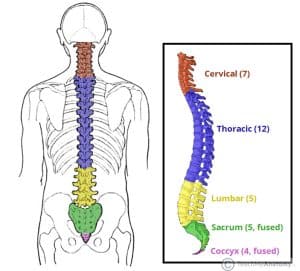The Silent Killer: How Your Bad Posture Is Destroying Your Health
We all know that slouching or hunching over is not great for our appearance, but did you know that it can also have serious health consequences, particularly for the neck and spine?
In fact, research has shown that poor posture can lead to a whole host of health problems, from back pain and muscle tension to decreased lung capacity and even digestive issues. And the neck and spine are particularly vulnerable to the negative effects of poor posture, as they bear the brunt of the strain caused by bad alignment.
But don't worry, it's not all doom and gloom! The good news is that by taking proactive measures to improve your posture, you can prevent these health problems and feel better in your body overall. In the rest of this post, we'll be diving deeper into the negative health consequences of poor posture, with a focus on the impact on the neck and spine. We'll also be sharing practical exercises and tips to combat bad posture and strengthen your neck muscles.
So if you've ever struggled with neck pain or noticed that your posture could use some improvement, then you're in the right place. Keep reading to learn more about how your bad posture may be silently sabotaging your health - and what you can do about it.
The Negative Health Consequences of Poor Posture
Alright, let's get into it. So what exactly are the negative health consequences of poor posture? Well, first of all, it can cause a lot of pain and discomfort in your neck and back. When you're hunched over, your muscles have to work harder to hold you up, which can lead to muscle fatigue and tension. Over time, this can result in chronic pain and even injuries.
But the problems don't stop there. Poor posture can also affect your breathing and digestion. When your chest is compressed and your shoulders are rounded forward, it can be harder to take deep breaths and get enough oxygen. And when your organs are compressed, it can affect their function and lead to issues like acid reflux.
And that's not all - research has also linked poor posture to increased stress and anxiety, decreased energy levels, and even a higher risk of cardiovascular disease.
But don't worry, there are plenty of exercises you can do to combat the negative effects of poor posture and improve your alignment. One of my favorites is the chin tuck exercise. Here's how to do it:
- Start by sitting up straight with your shoulders relaxed.
- Gently tuck your chin in towards your chest, keeping your neck long and your head level.
- Hold for a few seconds, then release and repeat.
This exercise helps to strengthen the muscles in your neck and upper back and improve your posture. Another great exercise is the shoulder winging. Here's how to do it:
- Sit up straight with your shoulders relaxed.
- Squeeze your shoulder blades together, as if you're trying to hold a pencil between them.
- Then extend your arms above your head.
- The goal here is to keep contact with the wall with wrist, elbow, shoulder and head
This exercise helps to improve your posture by strengthening the muscles between your shoulder blades and opening up your chest.
So there you have it - the negative health consequences of poor posture and some exercises to combat them. Remember, improving your posture is an ongoing process, but by incorporating these exercises into your routine, you can start to feel better in your body and prevent health problems down the line.
The Impact of Poor Posture on the Neck and Spine
When we talk about poor posture, one of the areas that's most vulnerable is the neck and spine. Your neck and spine are made up of a complex network of bones, muscles, and nerves that work together to support your body and enable movement. But when your posture is off, it can put excessive strain on these areas and cause a whole host of problems.
Let's start with the anatomy. Your spine is made up of 33 individual vertebrae that are stacked on top of each other like building blocks. These vertebrae are separated by small discs that act as shock absorbers and allow for movement. Your neck, or cervical spine, is the top portion of your spine and is made up of seven vertebrae.

When your posture is poor, it can cause these vertebrae to become misaligned, which can put pressure on the discs and lead to herniated discs, bulging discs, and even nerve compression. This can cause pain, numbness, and tingling sensations in your neck, shoulders, and arms.
Additionally, poor posture can also cause muscle imbalances in the neck and upper back. When you're hunched over, your chest muscles become tight and your upper back muscles become weak. This can cause your shoulders to round forward and your head to jut out, which puts even more strain on your neck.
FOTO
To visualize this, try standing up and looking in the mirror. First, stand up straight with good posture - your ears should be in line with your shoulders, your shoulders should be in line with your hips, and your hips should be in line with your ankles. Now, try hunching over and rounding your shoulders forward - notice how your head juts out and your neck becomes compressed?
This exercise helps to strengthen the muscles in your neck and improve your posture. Another great exercise is the thoracic extension exercise. Here's how to do it:
- Sit on a ball with your legs in front of you and your hands behind your head.
- Slowly arch your upper back backwards, keeping your chin tucked and reach with the stick behind you
- Hold for a few seconds, then release and repeat.
This exercise helps to stretch out your chest muscles and improve your upper back posture.
The Importance of Taking Proactive Measures to Address Posture Issues
To truly address posture issues, we need to take proactive measures to correct them. Fortunately, there are plenty of practical steps you can take to improve your posture and prevent health problems down the line.
One of the most important things you can do is sit and stand with proper alignment. When you're sitting:
- make sure your feet are flat on the floor
- your back is straight
- your shoulders are relaxed.
- Your ears should be in line with your shoulders
- your hips should be in line with your ankles.
- If you're working at a desk, make sure your computer monitor is at eye level and your keyboard is at elbow height.
When you're standing:
- make sure you're distributing your weight evenly on both feet
- with your shoulders relaxed
- your head in a neutral position
- Avoid locking your knees
- tilting your pelvis forward or backward.
Another important step is to use ergonomic furniture and equipment. If you're spending a lot of time sitting, invest in a chair with good lumbar support and adjustability. Consider using a standing desk or a stability ball to improve your posture and engage your core muscles. And if you're working on a laptop, consider using an external keyboard and mouse to avoid hunching over.
Of course, exercise and stretching are also key components of good posture. In addition to the exercises we covered earlier, try incorporating these moves into your routine:
- Scap Retractions: Hold on to a table, chair or an exercise equipment. Lock out elbows and retract your shoulders. Do not bend your elbows and let your shoulders work:
- Shoulder Dislocation: Stand up straight and hold a stick. Then "dislocate" your shoulders in a wide grip and go from front to back without bending your elbows. Relax your knees and hips. A regression can be to do it with a resistance band.
- Child's pose: Start on your hands and knees, with your hands slightly in front of your shoulders. Lower your hips back towards your heels, stretching your arms out in front of you. Rest your forehead on the floor and take a few deep breaths.
Remember, small changes can make a big difference in promoting good posture and preventing health problems. By taking proactive measures and incorporating these tips into your routine, you can improve your posture and feel better in your body."
Conclusion
In conclusion, good posture is essential for our overall health and well-being. Poor posture can lead to a variety of negative health consequences, including neck pain, back pain, and even breathing difficulties. By improving our posture, we can reduce the risk of these problems and improve our quality of life.
We've covered a lot of ground in this post, including the negative health consequences of poor posture, the impact of poor posture on the neck and spine, and practical tips for improving your posture. Remember, it's not enough to simply be aware of the importance of good posture - you need to take proactive measures to address any posture problems you may have.
Incorporating exercises and stretches into your routine, using ergonomic furniture and equipment, and sitting and standing with proper alignment are all great ways to improve your posture. And don't forget, small changes can make a big difference in the long run.
So if you've been slouching at your desk or hunching over your phone, take action today to correct your posture. Your body will thank you for it in the long run!
If you're still not sure where to begin, book a call with us and tell us what's up. We're more than welcome to help you get started! Check out this full-on workout routine to correct your posture. Do this everyday and feel the improvement!
